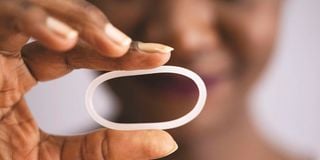Could this be the magic birth control method for women?

The vaginal ring, a new innovation, is not yet routinely available locally.
What you need to know:
- Progesterone-based hormonal contraceptives are available in daily pills, three-monthly injections, arm implants, and the hormonal intra-uterine system.
- The combined oestrogen and progesterone contraceptives are available in pills, injections, skin patches and now the novel vaginal ring. It is mind-boggling to imagine what other technological advances are in development.
Krista* sat across from me spotting a pink hairdo. She was frustrated. She did not handle her frustration too well but was always willing to listen to her options.
I met Krista a year ago when she was brought to the clinic by her older sister. She was a few months away from her final exams and her sister was worried about her getting her godawful periods during the exams. Apparently, Krista had periods that could only be described as terrorising.
Krista started her periods at 15, a little later than most of her peers. From the beginning, they were extremely painful, though thankfully, they only lasted three days. The flow was not heavy but the pain was something else. She also had nausea and accompanying diarrhoea. This was not an acceptable situation during the final exams.
After a thorough review and a few tests, there was nothing functionally wrong with Krista. She just suffered severe primary dysmenorrhea. Painkillers were not very helpful since she would just throw the right back up. We started Krista on the combined contraceptive pill as a treatment for the period pain. However, she struggled with remarkable nausea and vomiting, and by the fifth day, it was clear that she could not keep down the pill.
We had to get creative. Krista went on the combined contraceptive skin patch. This came with a lot of relief. She did not have to worry about vomiting like in the case of the pill. This also allowed her body to take in the hormones and get accustomed to them. The side effects began to subside.
Unfortunately, her skin was sensitive to the skin patch adhesive and she would itch a lot. Upon removing the patch at the end of the week to replace it with a new one, she would have little square dark patches left behind that would take too long to fade. Continued use did not seem to make the reaction fade.
Despite the maddening side effects, the use of the combined contraceptive hormones gave her welcome relief from the crazy period pains. Three months after initiating treatment, Krista comfortably sat for her exams and successfully completed high school. With the emergency now behind her, we could revisit her options.
For a few months, Krista faithfully came for a shot of the hormones every 28 days. This allowed her to have a consistent 28-day cycle, with minimal period pain. However, with campus looming and a possible change of lifestyle with demanding classes, it was becoming glaringly obvious that the injection was not sustainable.
Krista mentioned that her sister was in the United States and this gave us an opportunity to get help! Clearly, the combination hormones, estrogen and progesterone, was working for Krista. What we were struggling with was how to deliver them into the body. The oral route for the pills had failed, the skin patches for absorption through the skin had also failed and now, the injection was not tenable. We needed an innovative route.
The vaginal ring option came to mind! This new innovation, which is not yet routinely available locally, made sense! Krista could avoid the nausea, the itching, and the needles with this little magical ring! She had nothing to lose. Every time she got off the contraceptive, her period pains would be back with a vengeance. With time, even the nausea and diarrhoea had also remarkably subsided and Krista could remain functional during her menses.
Krista’s sister was able to come home with the two options currently available in the American market, the NuvaRing and the Annovera. The NuvaRing is a monthly dose. The ring is inserted vaginally and lasts for three weeks before it is removed and discarded. The Annovera is the equivalent of a year’s dose. It is inserted for three weeks, removed for a week, and reinserted for the next cycle, for a total of 13 cycles.
We started Krista off on the monthly option and she handled it pretty well. With time she became quite savvy at using the method, much to everyone’s relief. I was glad she had found an option that would help her find relief but one that also firmly put control in her own hands. She did not need to see me too often and she could focus on life without undue distraction.
The continuous development of new contraceptives is a highly appreciated contribution to science. When it comes to contraceptives, there will never be a one-size-fits-all option. With non-hormonal contraceptives, there is room for enhanced creativity, though new methods are slow in coming by. With hormonal contraceptives, the hormones remain the same, the difference is in how the hormone enters the body.
Progesterone-based hormonal contraceptives are available in daily pills, three-monthly injections, arm implants, and the hormonal intra-uterine system. The combined oestrogen and progesterone contraceptives are available in pills, injections, skin patches and now the novel vaginal ring. It is mind-boggling to imagine what other technological advances are in development.
Though traditionally viewed as contraceptives only, these hormones are used for a myriad of gynaecological conditions as treatment. These include primary dysmenorrhea, like in Krista’s case; adenomyosis; endometriosis; premenstrual dysphoric disorder and polycystic ovarian disorder.
It is important to note that irrespective of the indication for using these hormones, the patient’s suitability must be evaluated first and thereafter the patient monitored for side effects, which are managed accordingly. There are patients for whom these hormonal treatments are absolutely contraindicated, hence the need for prescription by a trained health professional.
Krista continues to thrive but she also remains a constant reminder of our limitation to accessing more suitable options for women and girls like her, who do not have the privilege that she does. It takes an average of up to 10 years before some of these technologies are available to Africa as a market. Despite the challenges, we continue to appreciate the impact of technology in making the lives of our patients and clients easier!
Dr Bosire is an obstetrician/ gynaecologist





